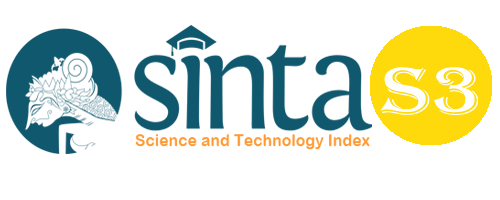Determinants of Business Sustainability in Small and Medium Enterprises of Fish Pond Cultivation through Financial Capability Strategy and Organizational Agility
Abstract
Micro, Small and Medium Enterprises (MSMEs) in the aquaculture business sector in Indonesia are able to be resistant in facing global economic changes, and are able to become the backbone of the local and national economy. In addition to being an opportunity, changes in the business environment tend to be uncertain, and become a threat that is difficult to control. The failure of SMEs in the aquaculture sector to adapt will threaten business sustainability in the future. So, it is necessary to have a strategy at the organizational level in managing these threats. This article attempts to measure the implementation of financial capability and organizational agility as antecedents of business sustainability. The unit of analysis that was measured was MSME fishpond cultivation in Kampar Regency. Based on Slovin's formula, the number of samples needed is 98 people. The data analysis process uses the SEM method through a partial least square approach. Based on the results of the analysis, fish pond cultivation SMEs in Kampar Regency have implemented all dimensions of financial capability as a strategy to take advantage of opportunities that arise in the market to create business sustainability. The results of data processing through the SEM method, one of the dimensions of the construct, namely organizational agility, gets a weak significance or probability value on business sustainability. This proves that fish pond cultivation SMEs have not optimized all their resources to adapt to changes in the business environment. The findings of this study indicate that with financial management in the aspect of human resources, agility characteristics will be created where business actors/fish pond farmers can quickly adapt to changes in technology that are currently developing, through the use of venture financing services from non-bank financial institutions.
Keywords
Full Text:
PDFReferences
Abidi, D., & Nakagawa, K. (2018). Innovation in VUCA world: evidence from Tunisian firms in a post-revolution context. International Journal of Business and Emerging Markets, 10(4). https://doi.org/10.1504/ijbem.2018.10016729
Achmad, W. (2022). Corporate Social Responsibility and Zakat: A Model of Philanthropy in the Society Era 5.0. Jurnal Scientia, 11(01), 565-574.
Andri, S., Arifin, K., & Febrian, A. F. (2020). The influence of ict capability on competitive advantage of small businesses through entrepreneurial orientation and organisational agility-the case of apparel retailers in Pekanbaru Indonesia. International Journal of Innovation, Creativity and Change, 12(4).
Barney, J. (1991). Firm Resources and Sustained Competitive Advantage. Journal of Management, 17(1), 99–120. https://doi.org/10.1177/014920639101700108
Baumgartner, R. J., & Ebner, D. (2010). Corporate sustainability strategies: Sustainability profiles and maturity levels. Sustainable Development, 18(2), 76–89. https://doi.org/10.1002/sd.447
BPS. (2021). Statistik Indonesia: Statistical Yearbook Of Indonesia 2022. Statistik Indonesia 2020, 1101001.
Day, R. H. (1984). Disequilibrium economic dynamics. A post-Schumpeterian contribution. Journal of Economic Behavior and Organization, 5(1), 57–76. https://doi.org/10.1016/0167-2681(84)90026-X
De Meza, D., Irlenbusch, B., & Reyniers, D. (2008). Financial Capability: A Behavioural Economics Perspective. Financial Services Authority, July, 5–108.
Entebang, H., Mansor, S. A., & Puah, C. (2006). Corporate Entrepreneurial Orientations in State Owned Enterprises in Malaysia.
Fatoki, Olawale. (2012). The Impact of Networking on Access to Debt Finance and Performance of Small and Medium Enterprises in South Africa. Journal of Social Sciences. https://doi.org/10.1080/09765239.2013.11884969
Filser, M., Eggers, F., Kraus, S., & Málovics, É. (2014). The effect of financial resource availability on entrepreneurial orientation, customer orientation and firm performance in an international context: An empirical analysis from Austria and Hungary. Journal for East European Management Studies, 19(1), 7–30. https://doi.org/10.1688/JEEMS-2014-01-Filser
Fonseka, M. M., Tian, G., & Li, L. (2014). Impact of financial capability on firms’ competitiveness and sustainability. Chinese Management Studies, 8(4), 593–623. https://doi.org/10.1108/CMS-09-2011-0066
Grootaert, C., & Van Bastelaer, T. (2002). Understanding and measuring social capital.
Hardwig, T. (2017). How Small Medium Enterprises create an agile collaborative work culture. IFKAD 2017: 12th International Forum On Knowledge Asset Dynamics: Knowledge Management In The 21st Century: Resilience, Creativity And Co-Creation.
Huang, J., Nam, Y., & Lee, E. J. (2015). Financial Capability and Economic Hardship Among Low-Income Older Asian Immigrants in a Supported Employment Program. Journal of Family and Economic Issues. https://doi.org/10.1007/s10834-014-9398-z
Kim, M., Surroca Aguilar, J., & Tribo Gine, J. A. (2009). The effect of social capital on financial capital.
Kourilsky, M. L., & Walstad, W. B. (2002). The Early Environment and Schooling Experiences of High-Technology Entrepreneurs : Insights for Entrepreneurship Education. International Journal of Entrepreneurship Education, 1(1), 1–20.
Kraus, S., Rigtering, J. P. C., Hughes, M., & Hosman, V. (2012). Entrepreneurial orientation and the business performance of SMEs: a quantitative study from the Netherlands. Review of Managerial Science, 6(2), 161–182. https://doi.org/10.1007/s11846-011-0062-9
Liana, L. (2015). Analisis Usaha Budidaya Perikanan Air Tawar di Kabupaten Kampar Provinsi Riau. Jurnal Dinamika Pertanian, XXX(1).
Lu, Y., & Ramamurthy, K. (2011). Understanding the link between information technology capability and organizational agility: An empirical examination. MIS Quarterly: Management Information Systems, 35(4). https://doi.org/10.2307/41409967
Omri, A., & Ayadi-Frikha, M. (2014). Constructing a mediational model of small business growth. International Entrepreneurship and Management Journal. https://doi.org/10.1007/s11365-012-0223-6
Penrose, E. (1959). Theory of the growth of the firm. In Theory of the Growth of the Firm.
Perikanan, K. K. dan. (2018). Statistik Kementerian Kelautan dan Perikanan. Https://Statistik.Kkp.Go.Id/, 16.
Poortinga, W. (2012). Community resilience and health: The role of bonding, bridging, and linking aspects of social capital. Health and Place, 18(2). https://doi.org/10.1016/j.healthplace.2011.09.017
Prawira W, R., Maulida, H., & Achmad, W. (2021). Narrating the Implementation of Social Welfare Community Program. Review of International Geographical Education Online, 11(5), 228-235.
Preibisch, K., Dodd, W., & Su, Y. (2016). Pursuing the capabilities approach within the migration–development nexus. Journal of Ethnic and Migration Studies, 42(13), 2111–2127. https://doi.org/10.1080/1369183X.2016.1176523
Priyono, A., Idris, F., & Lim, S. B. A. H. (2020). Achieving ambidexterity in internationalization: Analysis of how smes cope with tensions between organizational agility–efficiency. Journal of Open Innovation: Technology, Market, and Complexity, 6(4). https://doi.org/10.3390/joitmc6040188
Qosasi, A., Maulina, E., Purnomo, M., Muftiadi, A., Permana, E., & Febrian, F. (2019). The impact of information and communication technology capability on the competitive advantage of small businesses. Industrial Engineering, 10(1).
Sambamurthy, Bharadwaj, & Grover. (2003). Shaping Agility through Digital Options: Reconceptualizing the Role of Information Technology in Contemporary Firms. MIS Quarterly, 27(2), 237. https://doi.org/10.2307/30036530
Syofyan, I. (2011). Studi Kualitas Air untuk Kesehatan Ikan Dalam Budidaya Perikanan Pada Aliran Sungai Kampar Kiri. Jurnal Perikanan Dan Kelautan, 16.
Taylor, M, Jenkins, S., & Sacker, A. (2009). Financial capability and wellbeing: Evidence from the BHPS. Occasional Papers in Financial Regulation, 34(May), 1–98. http://www.fsa.gov.uk/pubs/occpapers/op34.pdf
Wiadnya, D. G. R. (2011). Konsep perencanaan minapolitan dalam pengembangan wilayah. Fakultas Perikanan & Ilmu Kelautan (FPIK), Universitas Brawijaya (UB)-Malang.
Wimba, I. G. A. (2015). Pengaruh Modal Sosial Terhadap Orientasi Kewirausahaan Dan Biaya Transaksi Untuk Meningkatkan Kinerja Usaha Pada Ukm Kerajinan Kayu Di Provinsi Bali. Universitas Udayana.
WOLD, H. (1973). Nonlinear Iterative Partial Least Squares (NIPALS) Modelling: Some Current Developments. In Multivariate Analysis–III. https://doi.org/10.1016/b978-0-12-426653-7.50032-6
Yantos. (2016). Kebijakan Pemerintah Kabupaten Kampar Terhadap Peningkatan Daya Saing Umkm Desa Koto Mesjid Dalam Menghadapi Masyarakat Ekonomi Asean (Mea). Jurnal RISALAH, 27(1).
Yusrizal, Y., Darwis, D., & Umar, Z. (2018). Strategi Pembangunan Perikanan Budidaya Di Kabupaten Kampar Provinsi Riau. Berkala Perikanan Terubuk, 46(2). https://doi.org/10.31258/terubuk.46.2.66-79
Yusuff, Y. Z., Bakar, A. A., & Ahmad, S. (2018). Relationship Between Financial Capital, Social Capital and Women Entrepreneurs’ Business Performance. Advanced Science Letters, 24(1), 202–204.
Zakaria, N. F., & Sabri, M. F. (2013). Review of Financial Capability Studies. International Journal of Humanities and Social Science, 3(9), 197–203.
DOI: https://doi.org/10.33258/birci.v5i4.7218
Article Metrics
Abstract view : 59 timesPDF - 16 times
Refbacks
- There are currently no refbacks.

This work is licensed under a Creative Commons Attribution-ShareAlike 4.0 International License.

This work is licensed under a Creative Commons Attribution-ShareAlike 4.0 International License.

_.gif)

















_.gif)



